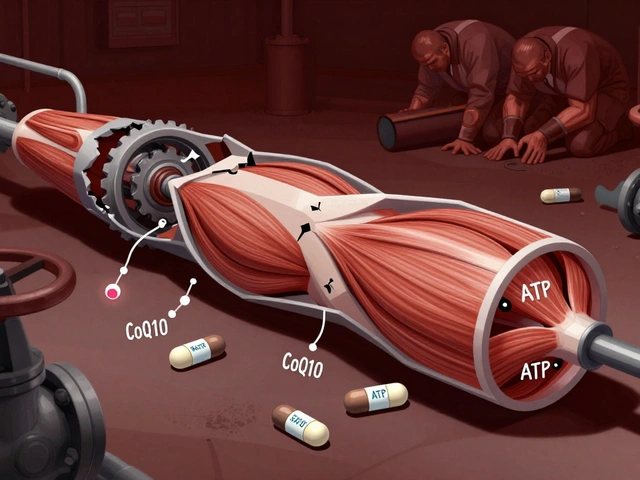
IBD Medication Comparison Tool
Disease Information
Disease Location
Severity
Side Effect Tolerance
Treatment Goal
Living with Crohn's disease or ulcerative colitis means juggling daily symptoms, diet, and, of course, medication. If you’ve been prescribed Entocort a delayed‑release budesonide capsule approved for mild‑to‑moderate Crohn’s disease affecting the ileum and right colon, you might wonder whether there’s a cheaper pill, fewer side‑effects, or a drug that works faster. This guide lines up Entocort against the most common alternatives, so you can see which option fits your lifestyle, budget, and disease severity.
Key Takeaways
- Entocort delivers high local steroid concentrations with minimal systemic exposure, ideal for limited‑area Crohn’s.
- Prednisone offers rapid symptom control but carries a higher risk of weight gain, bone loss, and mood swings.
- Mesalamine (5‑ASA) is safe for ulcerative colitis but less effective for Crohn’s disease.
- Immunomodulators (azathioprine, 6‑MP) work over months and help maintain remission.
- Biologics (infliximab, adalimumab, vedolizumab, ustekinumab) are powerful for moderate‑to‑severe disease but require injections or infusions and are cost‑lier.
How Entocort Works
Budesonide is a synthetic glucocorticoid that binds to glucocorticoid receptors in the gut lining. Its high first‑pass metabolism in the liver means only about 10% reaches systemic circulation, drastically reducing classic steroid side‑effects. The capsule releases the drug in the distal ileum and ascending colon, where most Crohn’s lesions reside.
Top Alternatives to Consider
Below are the main drug families doctors turn to when Entocort isn’t suitable or when disease progresses.
1. Prednisone (Oral Corticosteroid)
Prednisone a short‑acting systemic steroid used for rapid flare control in IBD works everywhere in the body. It’s cheap and fast‑acting but often leads to weight gain, high blood sugar, insomnia, and long‑term bone loss.
2. Mesalamine (5‑ASA)
Mesalamine an anti‑inflammatory agent that inhibits COX and lipoxygenase pathways in the colon is the go‑to for mild ulcerative colitis. It has a superb safety profile but limited efficacy for Crohn’s, especially when disease is beyond the colon.
3. Azathioprine / 6‑Mercaptopurine (Immunomodulators)
Azathioprine a purine analog that dampens the immune response by inhibiting DNA synthesis in lymphocytes (often paired with 6‑mercaptopurine) takes 8‑12 weeks to show benefit. It’s useful for maintaining remission but requires regular blood monitoring for liver toxicity and low white‑cell counts.
4. Infliximab (Anti‑TNF Biologic)
Infliximab a chimeric monoclonal antibody that neutralizes tumor necrosis factor‑α, a key driver of inflammation is administered by IV infusion every 8 weeks after induction. It can heal deep ulcers and fistulas but costs thousands per infusion and increases infection risk.
5. Adalimumab (Anti‑TNF Subcutaneous Biologic)
Similar to infliximab, Adalimumab a fully human anti‑TNF‑α antibody delivered via self‑injection offers more flexibility. Dosing is every two weeks, and the price is comparable to infliximab.
6. Vedolizumab (Gut‑Selective Integrin Inhibitor)
Vedolizumab an antibody that blocks α4β7 integrin, preventing white‑cells from entering the gut lining is praised for a lower systemic infection rate, but response can be slower (12‑16 weeks).
7. Ustekinumab (IL‑12/23 Inhibitor)
Ustekinumab targets interleukins‑12 and ‑23, key cytokines in Crohn’s inflammation is administered as a single IV dose then subcutaneous every 8‑12 weeks. It’s a good option for patients who failed anti‑TNF therapy.
Side‑Effect Snapshot
| Drug | Common Side‑Effects | Serious Risks | Typical Cost (AU$) |
|---|---|---|---|
| Entocort (Budesonide) | Nausea, mild headache | Rare adrenal suppression | ~150 per 30‑capsule pack |
| Prednisone | Weight gain, insomnia | Osteoporosis, diabetes | ~30 per 20‑tablet bottle |
| Mesalamine | Abdominal pain, headache | Kidney issues (rare) | ~80 per 30‑tablet pack |
| Azathioprine | Nausea, fatigue | Liver toxicity, bone‑marrow suppression | ~60 per month supply |
| Infliximab | Infusion reactions, fatigue | Serious infections, lymphoma | ~4,500 per infusion |
| Adalimumab | Injection site pain, headache | Serious infections | ~3,800 per month |
| Vedolizumab | Joint pain, nausea | Rare progressive multifocal leukoencephalopathy | ~4,200 per infusion |
| Ustekinumab | Upper‑respiratory infection | Serious infections, candida | ~5,000 per dose |

Choosing the Right Drug: Decision Criteria
- Location & extent of disease - Entocort shines when inflammation is confined to the ileum/right colon.
- Speed of relief needed - Prednisone works within days; biologics may need weeks.
- Side‑effect tolerance - If bone health is a concern, avoid long‑term systemic steroids.
- Cost & insurance coverage - Generic steroids and 5‑ASA are cheap; biologics often need private insurance approval.
- Administration preference - Capsules vs. injections vs. infusions.
- Long‑term goals - Maintenance therapy (azathioprine, biologics) vs. short‑burst flare control.
Best‑Fit Scenarios
- Recently diagnosed, mild Crohn’s limited to the terminal ileum - Entocort offers targeted therapy with low systemic risk.
- Severe flare, need rapid control - Prednisone is the fastest, then taper to a steroid‑sparing agent.
- Patient prefers oral meds and worries about injections - Mesalamine (if ulcerative colitis) or azathioprine for maintenance.
- Fistulizing Crohn’s or refractory disease - Biologics such as infliximab or adalimumab.
- History of steroid‑induced osteoporosis - Skip systemic steroids; consider vedolizumab or ustekinumab.
Practical Tips for Switching or Adding Therapy
- Consult your gastroenterologist before stopping any steroid; abrupt withdrawal can cause adrenal crisis.
- If moving from Entocort to a systemic steroid, overlap for 5‑7 days to avoid rebound inflammation.
- For immunomodulators, baseline labs (CBC, LFTs) are mandatory; re‑check every 2-3 months.
- Biologics require pre‑screening for tuberculosis and hepatitis.
- Keep a symptom diary - note stool frequency, bleeding, pain scores. This helps the doctor fine‑tune dosing.
Bottom Line: When Entocort alternatives Make Sense
If your disease is confined, you tolerate capsules, and you want to dodge the classic steroid baggage, Entocort stays hard to beat. However, when inflammation spreads, you need faster relief, or the cost of prolonged Budesonide outweighs its benefits, the alternatives listed above become viable options. Always weigh disease location, side‑effect profile, and personal lifestyle before swapping drugs.
Frequently Asked Questions
Can I take Entocort and a biologic at the same time?
Sometimes doctors combine a short course of Budesonide with a biologic to bridge the gap while the biologic builds up effectiveness. This approach is short‑term (usually 4-8 weeks) and requires close monitoring of blood pressure and blood sugar.
Is Entocort safe during pregnancy?
Budesonide is classified as Category B in Australia, meaning animal studies haven’t shown risk and there are no well‑controlled studies in humans. Many specialists consider it safer than systemic steroids, but you should still discuss any medication with your obstetrician.
How long should I stay on Entocort before switching?
A typical course lasts 8-12 weeks. If symptoms haven’t improved by week 4, your doctor may add or swap to a systemic steroid or immunomodulator.
What triggers higher systemic absorption of Budesonide?
Concurrent use of CYP3A4 inhibitors (e.g., ketoconazole, ritonavir) can raise blood levels, increasing side‑effect risk. Always inform your pharmacist about other meds.
Are there any diet changes that enhance Entocort’s effectiveness?
A low‑residue diet during flare‑ups can reduce bowel volume, allowing the capsule to release Budesonide nearer the inflamed area. Probiotics and omega‑3 supplementation may also support long‑term remission, but evidence is modest.









18 Comments
Steve here – I totally get the balancing act you’re describing. When the disease is locked to the ileum, Entocort really shines like a spotlight on a stage. It gives you that targeted steroid punch without the usual systemic drama. If you’re watching your bone health and want to keep steroids off‑label, this is the hero drug for the moment. Keep a diary of your flare‑ups and you’ll see the pattern emerge like a plot twist in a good novel.
Harold: Nice rundown, really helpful.
Sunil might add: While the table is exhaustive, one cannot ignore the economic shadows that loom over biologics. It is almost comical how the market drives patients to systemic steroids, despite the availability of a locally acting budesonide. The irony is palpable, especially when insurance barriers turn a simple capsule into a luxury.
Shana: I hear the concern about side‑effects, and it’s a very real worry. Entocort’s low systemic absorption is a blessing for those fearful of bone loss. Yet, if your disease spreads beyond the right colon, you may need to think bigger. The guide’s emphasis on location really matters – it isn’t just a box‑tick exercise.
Jillian: Look, the pharma giants want you glued to their infusion chairs while they count the pennies. They’ll paint every new biologic as the only salvation, but don’t forget the silent agenda behind those glossy brochures. Medicine isn’t just about molecules; it’s a battle of narratives.
Lindsey: Hey folks, if you’re on Entocort and wondering when to consider a step‑up, remember the “maintenance” checkpoint. After a solid 8‑12 week trial, if stools are still riding a roller‑coaster, bring up azathioprine with your doc. Also, keep an eye on liver enzymes – they love to surprise you after a few months. Small tip: a probiotic with Saccharomyces boulardii can sometimes smooth the transition.
Zachary: While Lindsey’s advice is – well – practically sound, one must also critique the superficial reliance on “capsules”. True therapeutic sophistication demands scrutiny of pharmacokinetic profiles – not just brand‑name comfort 😏.
Stacy: This whole discussion ignores the fact that America’s health system is rigged. If you’re not a citizen, these options are meaningless.
Kim and Lin: 🔥 great points above – especially the diary tip! Keep that log and you’ll spot patterns faster than a detective. 💪
Kemari: Concise summary – Entocort for limited ileal disease, systemic steroids for rapid control, biologics for severe cases.
Ellie: The drama of this therapeutic maze is almost theatrical. When you’re stuck between fast relief and long‑term safety, the stakes feel like a cliffhanger. Remember, every switch is a scene change – don’t rush the curtain.
Brandi: The guide paints a picture that is both comprehensive and, frankly, overwhelming. It starts with the promise of a simple decision tree, then quickly spirals into a labyrinth of drug names and side‑effect tables. You are told that Entocort delivers high local steroid concentrations with minimal systemic exposure, which sounds like a miracle for those with limited disease. Yet the same paragraph warns that once the disease spreads, you might need to consider systemic steroids or even biologics. This dichotomy forces the patient into a perpetual state of vigilance. The table of side‑effects is exhaustive, listing nausea, weight gain, infusion reactions, and even rare lymphoma. Such a list can frighten anyone who is already dealing with the anxiety of a chronic illness. The cost column adds another layer of stress, showing that a single infusion of infliximab can cost thousands of dollars. When you factor in insurance approvals, the financial burden becomes a secondary disease. The guide also emphasizes the need for regular blood monitoring when using azathioprine, a reminder that even “maintenance” therapy is not without its own risks. It suggests a low‑residue diet during flare‑ups, which may help but also adds to the complexity of daily living. The practical tips for switching therapies are sensible, like overlapping Entocort with a systemic steroid for 5‑7 days to avoid rebound inflammation. However, the recommendation to keep a symptom diary feels almost redundant after all the other advice. Overall, the guide is a double‑edged sword – it empowers with information while simultaneously amplifying the fear of making the wrong choice.
Chip: Folks, let’s remember that each patient’s journey is unique. The choice between Entocort and a biologic isn’t just about tables; it’s about lifestyle, cultural background, and support systems. If you have a strong community and can handle self‑injection, adalimumab might fit well. If you prefer oral pills and have a busy schedule, staying on budesonide while monitoring symptoms could be the right path. Keep communicating with your gastroenterology team – they are your allies.
Prateek: Absolutely, Chip! 😃 Your inclusive tone really helps bridge the gap between clinical data and everyday life. 🌍
Noah: While everyone is waxing poetic about “personalized” care, the reality is that most insurers will only cover the cheapest generic – often forcing patients into suboptimal steroid courses.
Bridget: The therapeutic algorithm delineated herein is commendably exhaustive, yet one must interrogate the underlying pharmacoeconomic assumptions. In an era where biosimilars promise cost parity, the prescriptive hierarchy should arguably prioritize agents with proven biosimilarity, thereby mitigating fiscal constraints while preserving clinical efficacy.
Shweta: Indeed, Bridget; however, one must also consider the regulatory landscapes that dictate biosimilar adoption, which are, regrettably, fraught with regional discrepancies!!!
Gary: Let’s be honest – all this talk about “choice” is a smokescreen for a system that favors pharmaceutical monopolies over patient autonomy!!!